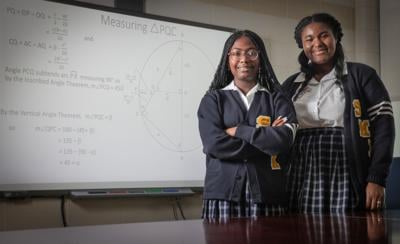Over their holiday break, most high school students relax, kick back and watch TV, visit with family, maybe take a trip. But on this last winter holiday, two New Orleans seniors at St. Mary’s Academy tackled a mathematical feat thought to be impossible for 2,000 years.
At some point in their education, every student learns that "A squared plus B squared equals C squared." This formula uses the Pythagorean Theorem to explain the relationship between the three sides of a right triangle.
Named for the Greek philosopher who created it, the theorem has been proven in many ways over thousands of years — but never by using trigonometry. Not until Calcea Johnson and Ne’Kiya Jackson got to work.
“We were the only two students that answered the bonus question on the math contest they gave us over the break,” Jackson said. “It asked you to create a proof for the theorem and asked a bunch of questions about how you would move from one step to the next.”
Both girls created different, but similar, proofs that disproved the accepted thinking that since trigonometry (the study of triangles) is itself based on the Pythagorean Theorem, any theory that tried to use it would be using false logic known as circular reasoning.
In their abstract, Johnson and Jackson countered this long-held belief stating, “that isn’t quite true. We present a new proof of Pythagoras’s Theorem which is based on a fundamental result in trigonometry — the Law of Sines — and we show that the proof is independent of the Pythagorean trig identity sin2x+cos2x=1.”
Something special
When they returned to school and their teachers saw their work, they knew it was something special and contacted the American Mathematical Society. Johnson and Jackson were then invited to do something few, if any, teens have ever done — present at a meeting of the American Mathematical Society.
“For two months we worked together nonstop — during school, after school, at home, at lunch,” said Johnson of the girls’ efforts to prepare for their presentation. “We had lots of Zoom meetings. Actually, during Mardi Gras break we were still working by Zoom.”
The big day came on March 18, when the girls stood in front of math students and scholars at the Spring Southeastern Meeting of the American Mathematical Society in Atlanta and presented their proof.
“It was nerve-wracking at first,” Johnson said. “We went to Georgia Tech and practiced the day before, so that helped."
Next steps
Among those in attendance at the presentation was the girls’ principal, Pamela Rogers.
“We were all very proud at their mastery of the subject matter and how they displayed it to the audience,” Rogers said. “I was particularly proud at how they answered the questions. We teach our students to be comfortable in any space, and they were.”
The journey may not be over.
In a statement, a spokesperson for the American Mathematical Society said that to be officially accepted in the field, new work must be examined for publication in a mathematics journal.
"Following their conference presentation, their next step would be to look into submitting their work to a peer-reviewed journal, where members of our community can examine their results to determine whether their proof is a correct contribution to the mathematics literature," said executive director Catherine A. Roberts.
Focus on the future
With their big presentation behind them, the girls are now focused on the future. Johnson and Jackson have both been accepted at multiple prestigious universities. Johnson noted she has so far received acceptance letters from 26 schools and a total of $1.2 million in scholarships.
Johnson names English as her favorite subject while Jackson prefers history — but both are aiming for STEM careers.
Jackson is currently torn between pharmacy or anesthesiology, while Johnson said is aiming to be an environmental engineer.
“I’ve always had a passion for problem solving,” Johnson said. “And my parents are big on the environment — they’re master gardeners. Plus, I come from a city which I love, that faces big environmental problems, and I feel it is my duty to help solve them.”

